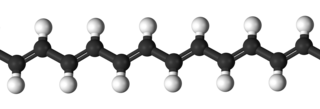
Bakelite or polyoxybenzylmethylenglycolanhydride was the first plastic made from synthetic components. It is a thermosetting phenol formaldehyde resin, formed from a condensation reaction of phenol with formaldehyde. It was developed by the Belgian-American chemist Leo Baekeland in Yonkers, New York, in 1907.

Leo Hendrik Arthur Baekeland (November 14, 1863 – February 23, 1944) was a Belgian chemist. He is best known for the inventions of Velox photographic paper in 1893 and Bakelite in 1907. He has been called "The Father of the Plastics Industry" for his invention of Bakelite, an inexpensive, nonflammable and versatile plastic, which marked the beginning of the modern plastics industry.

Union Carbide Corporation is an American chemical corporation wholly owned by Dow Chemical Company. It currently employs more than 2,400 people. Union Carbide produces chemicals and polymers that undergo one or more further conversions by customers before reaching consumers. Some are high-volume commodities and others are specialty products meeting the needs of smaller markets. Markets served include paints and coatings, packaging, wire and cable, household products, personal care, pharmaceuticals, automotive, textiles, agriculture, and oil and gas. The company is a former component of the Dow Jones Industrial Average.

Gutta-percha is a tree of the genus Palaquium in the family Sapotaceae. The name also refers to the rigid, naturally biologically inert, resilient, electrically nonconductive, thermoplastic latex produced from the sap of the tree, particularly from Palaquium gutta; it is a polymer of isoprene which forms a rubber-like elastomer.

Formica Laminate is a laminated composite material invented at the Westinghouse Electric Corporation in the United States in 1912. Originally used to replace mica in electrical applications, it has since been manufactured for a variety of applications. Today, the product is produced by New Zealand–based Formica Group, and has been since 2007. The word Formica refers to the company's classic product: a heat-resistant, wipe-clean laminate of paper or textile with melamine resin.
The Autopoint Company was a manufacturer of pencils and desk top accessories in Chicago for about 50 years from the 1920s to around 1970.
Lawrence V. Redman, was a Canadian chemist and businessman who spent much of his adult life in the United States. Redman was a pioneer in the industrial applications of plastics.
S. Karpen & Bros. was a Chicago-based furniture manufacturing firm that specialized in upholstered furniture.

Polymer science or macromolecular science is a subfield of materials science concerned with polymers, primarily synthetic polymers such as plastics and elastomers. The field of polymer science includes researchers in multiple disciplines including chemistry, physics, and engineering.
Hexion Inc. or Hexion is a chemical company based in Columbus, Ohio. It produces thermoset resins and related technologies and specialty products.

Bayko was a British building model construction toy invented by Charles Plimpton, an early plastics engineer and entrepreneur in Liverpool. First marketed in Britain it was soon exported throughout the British Commonwealth and became a worldwide brand between 1934 and 1967. The name derived from Bakelite, one of the world's first commercial plastics that was originally used to manufacture many of the parts. Bayko was one of the world's earliest plastic toys to be marketed.

Borden, Inc., was an American producer of food and beverage products, consumer products, and industrial products. At one time, the company was the largest U.S. producer of dairy and pasta products. Its food division, Borden Foods, was based in Columbus, Ohio, and focused primarily on pasta and pasta sauces, bakery products, snacks, processed cheese, jams and jellies, and ice cream. It was best known for its Borden Ice Cream, Meadow Gold milk, Creamette pasta, and Borden Condensed Milk brands. Its consumer products and industrial segment marketed wallpaper, adhesives, plastics and resins. By 1993, sales of food products accounted for 67 percent of its revenues. It was also known for its Elmer's Glue and Krazy Glue.

The National Historic Chemical Landmarks program was launched by the American Chemical Society in 1992 to recognize significant achievements in the history of chemistry and related professions. The program celebrates the centrality of chemistry. The designation of such generative achievements in the history of chemistry demonstrates how chemists have benefited society by fulfilling the ACS vision: Improving people's lives through the transforming power of chemistry. The program occasionally designates International Historic Chemical Landmarks to commemorate "chemists and chemistry from around the world that have had a major impact in the United States".

Faturan, in Middle Eastern beadwork, is a material used to make beads, notably in the making of komboloi and misbaha.
The plastics industry manufactures polymer materials—commonly called plastics—and offers services in plastics important to a range of industries, including packaging, building and construction, electronics, aerospace, and transportation.
Carleton Ellis was an American inventor and a pioneer in the field of organic chemistry. He was involved in the development of margarine, polyester, anti-knock gasoline, paint and varnish remover, and holder of 753 patents. A native of Keene, New Hampshire, he was the valedictorian of his high school class, and later a graduate of MIT. He then set up the Ellis Laboratories in Montclair, New Jersey.
Hemacite is a material made from sawdust and the blood of slaughtered animals cattle and pig. It was invented by Dr W H Dibble of New Jersey in the last quarter of the nineteenth century. Hydraulic pressure and chemical compounds, blood and sawdust were transformed by Dibble's Hemacite Manufacturing Company into everything from doorknobs and roller skate wheels to cash register buttons and telephone receivers; there is even extensive use in Victorian jewellery. Hemacite was inexpensive but fell out of favor with the popularity of new plastics like Bakelite, it is quite easy to misidentify Hemacite with Bakelite.
BX Plastics was a plastics engineering and production company. The company was one of three subsidiaries of the British Xylonite Company established by 1938. BX Plastics made xylonite and Lactoid at a plant to the south of Brantham in Suffolk, on the north bank of the River Stour across the river from Manningtree in Essex. The company was liquidated in 1999.

Plastics are a wide range of synthetic or semi-synthetic organic compounds that are malleable and so can be molded into solid objects.
Hooker Chemical Company, also known as Hooker Electrochemical Company, was an American chemical company that produced chloralkali products from 1903 to 1968. In 1922, Hooker bought the S. Wander & Sons company for the retail sales of lye and chlorinated lime. Hooker Chemical was best known for the chemical waste site Love Canal, which it sold in 1953, and which led to a lengthy lawsuit several decades later.










